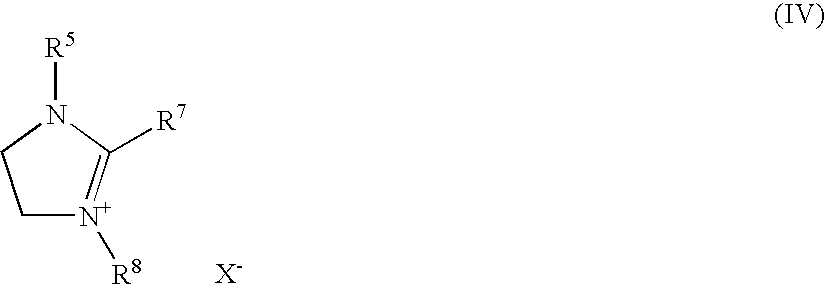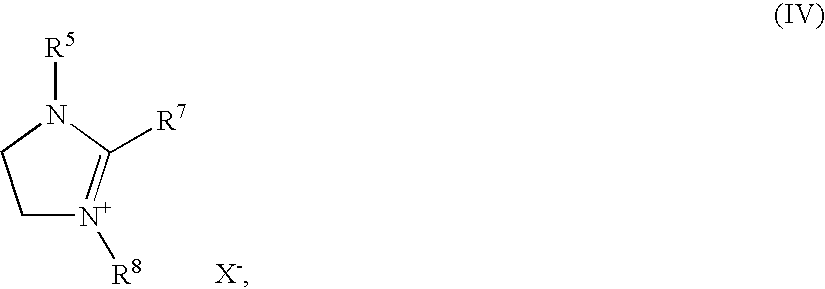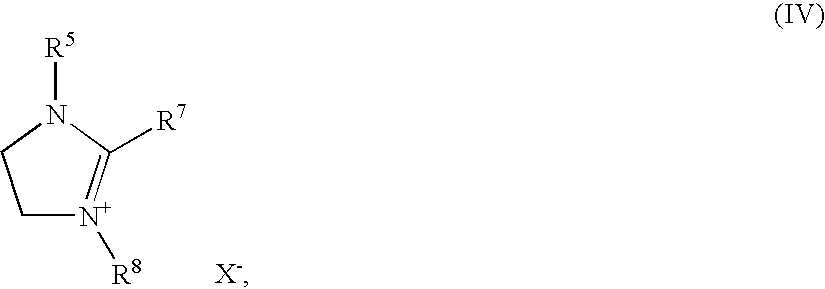Aqueous dispersions of organosilicon compounds
a technology of organosilicon and dispersions, which is applied in the field of aqueous dispersions of organosilicon compounds, can solve the problems of inability to achieve the desired stability and efficiency of aqueous compositions prepared according to the prior art, and achieve the effect of stable emulsions of alkylalkoxy-functional organosilicon compounds
- Summary
- Abstract
- Description
- Claims
- Application Information
AI Technical Summary
Benefits of technology
Problems solved by technology
Method used
Image
Examples
example 1
[0111]45 parts of isooctyltriethoxysilane (available under the name SILRES® BS 1701 from Wacker Chemie AG, Munich, Germany) are mixed with 1 part of ethoxylated sorbitan laurate (HLB=16.7) and 1 part of sorbitan laurate (HLB=8.6) using an Ultra-Turrax® (IKA®-Werke GmbH & Co. KG, Staufen, Germany). Thereafter, 52.3 parts of demineralized water (conductivity <5 μS / cm) are slowly added; a milky oil-in-water emulsion is obtained. 0.5 part of hexadecyltrimethylammonium chloride (available under the name Genamin® CTAC 50 from Clariant GmbH, Frankfurt, Germany) and 0.2 part of the preservative Acticide® BX(N) (available from Thor Chemie GmbH, Speyer, Germany) are also added to this emulsion. The emulsion thus obtained is homogenized using a high-pressure homogenizer (APV 2000, Invensys APV Unna) at 500 bar. A low-viscosity emulsion which has a volume-average particle size of 1.11 μm is obtained.
[0112]In order to test the quality and stability, the following tests were carried out on the em...
example 2
[0116]The procedure described in Example 1 is repeated, except that 0.75 part of an ethoxylated isotridecyl alcohol having 5 ethylene glycol groups (HLB=11.2), 0.75 part of an ethoxylated castor oil having 200 ethylene glycol groups (HLB=18.1) and 0.5 part of 1-methyl-2-norstearyl-3-stearic acid amidoethylimidazolinium methosulfate / propylene glycol 3:1 (available under the name Rewoquat® W 75 PG from Tego Service GmbH, Essen, Germany) are used as emulsifiers.
[0117]The results are shown in Table 1.
example 3
[0128]15 parts of the isooctyltriethoxysilane used in example 1 and 10 parts of octadecylmethyldimethoxysilane are mixed with 5 parts of an oligomeric alkoxysiloxane of the empirical formula CH3Si(OCH2CH3)0.8O1.1 and with 7 parts of a methylsilicone resin having a glass transition temperature of 45° C., an average molar mass of about 10,000 g / mol and a content of ethoxy groups of 2.8% by weight (available under the name SILRES® BS 1321 from Wacker Chemie AG, Munich, Germany), 0.25 part of aminoethyltriethoxysilane and 2 parts of a hydrophobized silicic acid (available under the name HDK® H 2000 from Wacker Chemie AG, Munich, Germany). The mixture thus obtained is processed with 1.2 parts of an ethoxylated isotridecyl alcohol having 16 ethylene glycol groups (HLB=15.5), 0.5 part of 1-methyl-2-norstearyl-3-stearic acid amidoethylimidazolinium methosulfate and 55 parts of water using an Ultra-Turrax to give an emulsion. 4 parts of a 50% strength aqueous emulsion of a polydimethylsiloxa...
PUM
| Property | Measurement | Unit |
|---|---|---|
| viscosity | aaaaa | aaaaa |
| viscosity | aaaaa | aaaaa |
| viscosity | aaaaa | aaaaa |
Abstract
Description
Claims
Application Information
 Login to View More
Login to View More - R&D
- Intellectual Property
- Life Sciences
- Materials
- Tech Scout
- Unparalleled Data Quality
- Higher Quality Content
- 60% Fewer Hallucinations
Browse by: Latest US Patents, China's latest patents, Technical Efficacy Thesaurus, Application Domain, Technology Topic, Popular Technical Reports.
© 2025 PatSnap. All rights reserved.Legal|Privacy policy|Modern Slavery Act Transparency Statement|Sitemap|About US| Contact US: help@patsnap.com



